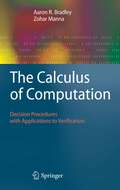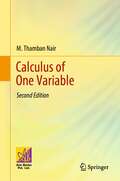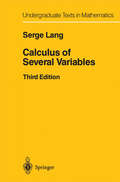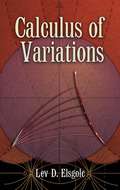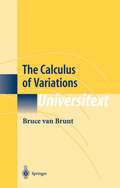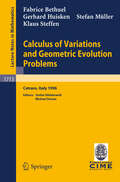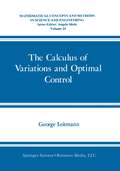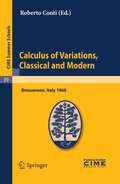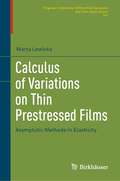- Table View
- List View
The Calculus of Computation: Decision Procedures with Applications to Verification
by Aaron R. Bradley Zohar MannaWritten with graduate and advanced undergraduate students in mind, this textbook introduces computational logic from the foundations of first-order logic to state-of-the-art decision procedures for arithmetic, data structures, and combination theories. The textbook also presents a logical approach to engineering correct software. Verification exercises are given to develop the reader's facility in specifying and verifying software using logic. The treatment of verification concludes with an introduction to the static analysis of software, an important component of modern verification systems. The final chapter outlines courses of further study.
Calculus of Fractions and Homotopy Theory (Ergebnisse der Mathematik und ihrer Grenzgebiete. 2. Folge #35)
by Peter Gabriel M. ZismanThe main purpose of the present work is to present to the reader a particularly nice category for the study of homotopy, namely the homo topic category (IV). This category is, in fact, - according to Chapter VII and a well-known theorem of J. H. C. WHITEHEAD - equivalent to the category of CW-complexes modulo homotopy, i.e. the category whose objects are spaces of the homotopy type of a CW-complex and whose morphisms are homotopy classes of continuous mappings between such spaces. It is also equivalent (I, 1.3) to a category of fractions of the category of topological spaces modulo homotopy, and to the category of Kan complexes modulo homotopy (IV). In order to define our homotopic category, it appears useful to follow as closely as possible methods which have proved efficacious in homo logical algebra. Our category is thus the" topological" analogue of the derived category of an abelian category (VERDIER). The algebraic machinery upon which this work is essentially based includes the usual grounding in category theory - summarized in the Dictionary - and the theory of categories of fractions which forms the subject of the first chapter of the book. The merely topological machinery reduces to a few properties of Kelley spaces (Chapters I and III). The starting point of our study is the category ,10 Iff of simplicial sets (C.S.S. complexes or semi-simplicial sets in a former terminology).
The Calculus of Friendship: What a Teacher and a Student Learned about Life while Corresponding about Math
by Steven StrogatzThe Calculus of Friendship is the story of an extraordinary connection between a teacher and a student, as chronicled through more than thirty years of letters between them. What makes their relationship unique is that it is based almost entirely on a shared love of calculus. For them, calculus is more than a branch of mathematics; it is a game they love playing together, a constant when all else is in flux. The teacher goes from the prime of his career to retirement, competes in whitewater kayaking at the international level, and loses a son. The student matures from high school math whiz to Ivy League professor, suffers the sudden death of a parent, and blunders into a marriage destined to fail. Yet through it all they take refuge in the haven of calculus--until a day comes when calculus is no longer enough. Like calculus itself, The Calculus of Friendship is an exploration of change. It's about the transformation that takes place in a student's heart, as he and his teacher reverse roles, as they age, as they are buffeted by life itself. Written by a renowned teacher and communicator of mathematics, The Calculus of Friendship is warm, intimate, and deeply moving. The most inspiring ideas of calculus, differential equations, and chaos theory are explained through metaphors, images, and anecdotes in a way that all readers will find beautiful, and even poignant. Math enthusiasts, from high school students to professionals, will delight in the offbeat problems and lucid explanations in the letters. For anyone whose life has been changed by a mentor, The Calculus of Friendship will be an unforgettable journey.
The Calculus of Friendship: What a Teacher and a Student Learned about Life while Corresponding about Math
by Steven StrogatzThe Calculus of Friendship is the story of an extraordinary connection between a teacher and a student, as chronicled through more than thirty years of letters between them. What makes their relationship unique is that it is based almost entirely on a shared love of calculus. For them, calculus is more than a branch of mathematics; it is a game they love playing together, a constant when all else is in flux. The teacher goes from the prime of his career to retirement, competes in whitewater kayaking at the international level, and loses a son. The student matures from high school math whiz to Ivy League professor, suffers the sudden death of a parent, and blunders into a marriage destined to fail. Yet through it all they take refuge in the haven of calculus--until a day comes when calculus is no longer enough. Like calculus itself, The Calculus of Friendship is an exploration of change. It's about the transformation that takes place in a student's heart, as he and his teacher reverse roles, as they age, as they are buffeted by life itself. Written by a renowned teacher and communicator of mathematics, The Calculus of Friendship is warm, intimate, and deeply moving. The most inspiring ideas of calculus, differential equations, and chaos theory are explained through metaphors, images, and anecdotes in a way that all readers will find beautiful, and even poignant. Math enthusiasts, from high school students to professionals, will delight in the offbeat problems and lucid explanations in the letters. For anyone whose life has been changed by a mentor, The Calculus of Friendship will be an unforgettable journey.
The Calculus of Happiness: How a Mathematical Approach to Life Adds Up to Health, Wealth, and Love
by Oscar E. FernandezHow math holds the keys to improving one's health, wealth, and love lifeWhat's the best diet for overall health and weight management? How can we change our finances to retire earlier? How can we maximize our chances of finding our soul mate?In The Calculus of Happiness, Oscar Fernandez shows us that math yields powerful insights into health, wealth, and love. Using only high-school-level math (precalculus with a dash of calculus), Fernandez guides us through several of the surprising results, including an easy rule of thumb for choosing foods that lower our risk for developing diabetes (and that help us lose weight too), simple "all-weather" investment portfolios with great returns, and math-backed strategies for achieving financial independence and searching for our soul mate. Moreover, the important formulas are linked to a dozen free online interactive calculators on the book’s website, allowing one to personalize the equations.Fernandez uses everyday experiences—such as visiting a coffee shop—to provide context for his mathematical insights, making the math discussed more accessible, real-world, and relevant to our daily lives. Every chapter ends with a summary of essential lessons and takeaways, and for advanced math fans, Fernandez includes the mathematical derivations in the appendices.A nutrition, personal finance, and relationship how-to guide all in one, The Calculus of Happiness invites you to discover how empowering mathematics can be.
Calculus of One Variable (Springer Undergraduate Mathematics Series)
by K.E. HirstAdopts a user-friendly approach, with an emphasis on worked examples and exercises, rather than abstract theory The computer algebra and graphical package MAPLE is used to illustrate many of the ideas and provides an additional aid to teaching and learning Supplementary material, including detailed solutions to exercises and MAPLE worksheets, is available via the web
Calculus of One Variable
by M. Thamban NairThis book is designed to serve as a textbook for courses offered to undergraduate and graduate students enrolled in Mathematics. The first edition of this book was published in 2015. As there is a demand for the next edition, it is quite natural to take note of the several suggestions received from the users of the earlier edition over the past six years. This is the prime motivation for bringing out a revised second edition with a thorough revision of all the chapters. The book provides a clear understanding of the basic concepts of differential and integral calculus starting with the concepts of sequences and series of numbers, and also introduces slightly advanced topics such as sequences and series of functions, power series, and Fourier series which would be of use for other courses in mathematics for science and engineering programs. The salient features of the book are - precise definitions of basic concepts; several examples for understanding the concepts and for illustrating the results; includes proofs of theorems; exercises within the text; a large number of problems at the end of each chapter as home-assignments. The student-friendly approach of the exposition of the book would be of great use not only for students but also for the instructors. The detailed coverage and pedagogical tools make this an ideal textbook for students and researchers enrolled in a mathematics course.
The Calculus of Selfishness
by Karl SigmundHow does cooperation emerge among selfish individuals? When do people share resources, punish those they consider unfair, and engage in joint enterprises? These questions fascinate philosophers, biologists, and economists alike, for the "invisible hand" that should turn selfish efforts into public benefit is not always at work. The Calculus of Selfishness looks at social dilemmas where cooperative motivations are subverted and self-interest becomes self-defeating. Karl Sigmund, a pioneer in evolutionary game theory, uses simple and well-known game theory models to examine the foundations of collective action and the effects of reciprocity and reputation. Focusing on some of the best-known social and economic experiments, including games such as the Prisoner's Dilemma, Trust, Ultimatum, Snowdrift, and Public Good, Sigmund explores the conditions leading to cooperative strategies. His approach is based on evolutionary game dynamics, applied to deterministic and probabilistic models of economic interactions. Exploring basic strategic interactions among individuals guided by self-interest and caught in social traps, The Calculus of Selfishness analyzes to what extent one key facet of human nature--selfishness--can lead to cooperation.
Calculus of Several Variables (Undergraduate Texts in Mathematics)
by Serge LangThis new, revised edition covers all of the basic topics in calculus of several variables, including vectors, curves, functions of several variables, gradient, tangent plane, maxima and minima, potential functions, curve integrals, Green’s theorem, multiple integrals, surface integrals, Stokes’ theorem, and the inverse mapping theorem and its consequences. It includes many completely worked-out problems.
Calculus of Variations
by Lev D. ElsgolcThis concise text offers both professionals and students an introduction to the fundamentals and standard methods of the calculus of variations. In addition to surveys of problems with fixed and movable boundaries, it explores highly practical direct methods for the solution of variational problems.Topics include the method of variation in problems with fixed boundaries; variational problems with movable boundaries and other problems; sufficiency conditions for an extremum; variational problems of constrained extrema; and direct methods of solving variational problems. Each chapter features numerous illustrative problems, and solutions appear at the end.
Calculus of Variations: An Introduction to the One-Dimensional Theory with Examples and Exercises (Texts in Applied Mathematics #67)
by Hansjörg KielhöferThis clear and concise textbook provides a rigorous introduction to the calculus of variations, depending on functions of one variable and their first derivatives. It is based on a translation of a German edition of the book Variationsrechnung (Vieweg+Teubner Verlag, 2010), translated and updated by the author himself. Topics include: the Euler-Lagrange equation for one-dimensional variational problems, with and without constraints, as well as an introduction to the direct methods. The book targets students who have a solid background in calculus and linear algebra, not necessarily in functional analysis. Some advanced mathematical tools, possibly not familiar to the reader, are given along with proofs in the appendix. Numerous figures, advanced problems and proofs, examples, and exercises with solutions accompany the book, making it suitable for self-study. The book will be particularly useful for beginning graduate students from the physical, engineering, and mathematical sciences with a rigorous theoretical background.
Calculus of Variations (Universitext)
by Filip RindlerThis textbook provides a comprehensive introduction to the classical and modern calculus of variations, serving as a useful reference to advanced undergraduate and graduate students as well as researchers in the field. Starting from ten motivational examples, the book begins with the most important aspects of the classical theory, including the Direct Method, the Euler-Lagrange equation, Lagrange multipliers, Noether’s Theorem and some regularity theory. Based on the efficient Young measure approach, the author then discusses the vectorial theory of integral functionals, including quasiconvexity, polyconvexity, and relaxation. In the second part, more recent material such as rigidity in differential inclusions, microstructure, convex integration, singularities in measures, functionals defined on functions of bounded variation (BV), and Γ-convergence for phase transitions and homogenization are explored. While predominantly designed as a textbook for lecture courses on the calculus of variations, this book can also serve as the basis for a reading seminar or as a companion for self-study. The reader is assumed to be familiar with basic vector analysis, functional analysis, Sobolev spaces, and measure theory, though most of the preliminaries are also recalled in the appendix.
The Calculus of Variations (Universitext)
by Bruce van BruntSuitable for advanced undergraduate and graduate students of mathematics, physics, or engineering, this introduction to the calculus of variations focuses on variational problems involving one independent variable. It also discusses more advanced topics such as the inverse problem, eigenvalue problems, and Noether’s theorem. The text includes numerous examples along with problems to help students consolidate the material.
Calculus of Variations and Geometric Evolution Problems: Lectures given at the 2nd Session of the Centro Internazionale Matematico Estivo (C.I.M.E.)held in Cetaro, Italy, June 15-22, 1996 (Lecture Notes in Mathematics #1713)
by F. Bethuel G. Huisken S. Mueller K. SteffenThe international summer school on Calculus of Variations and Geometric Evolution Problems was held at Cetraro, Italy, 1996. The contributions to this volume reflect quite closely the lectures given at Cetraro which have provided an image of a fairly broad field in analysis where in recent years we have seen many important contributions. Among the topics treated in the courses were variational methods for Ginzburg-Landau equations, variational models for microstructure and phase transitions, a variational treatment of the Plateau problem for surfaces of prescribed mean curvature in Riemannian manifolds - both from the classical point of view and in the setting of geometric measure theory.
Calculus of Variations and Nonlinear Partial Differential Equations: Lectures given at the C.I.M.E. Summer School held in Cetraro, Italy, June 27 - July 2, 2005 (Lecture Notes in Mathematics #1927)
by Luigi Ambrosio Luis A. Caffarelli Michael G. Crandall Lawrence C. Evans Nicola FuscoThis volume provides the texts of lectures given by L. Ambrosio, L. Caffarelli, M. Crandall, L.C. Evans, N. Fusco at the Summer course held in Cetraro, Italy in 2005. These are introductory reports on current research by world leaders in the fields of calculus of variations and partial differential equations. Coverage includes transport equations for nonsmooth vector fields, viscosity methods for the infinite Laplacian, and geometrical aspects of symmetrization.
The Calculus of Variations and Optimal Control: An Introduction (Mathematical Concepts and Methods in Science and Engineering #24)
by George LeitmannWhen the Tyrian princess Dido landed on the North African shore of the Mediterranean sea she was welcomed by a local chieftain. He offered her all the land that she could enclose between the shoreline and a rope of knotted cowhide. While the legend does not tell us, we may assume that Princess Dido arrived at the correct solution by stretching the rope into the shape of a circular arc and thereby maximized the area of the land upon which she was to found Carthage. This story of the founding of Carthage is apocryphal. Nonetheless it is probably the first account of a problem of the kind that inspired an entire mathematical discipline, the calculus of variations and its extensions such as the theory of optimal control. This book is intended to present an introductory treatment of the calculus of variations in Part I and of optimal control theory in Part II. The discussion in Part I is restricted to the simplest problem of the calculus of variations. The topic is entirely classical; all of the basic theory had been developed before the turn of the century. Consequently the material comes from many sources; however, those most useful to me have been the books of Oskar Bolza and of George M. Ewing. Part II is devoted to the elementary aspects of the modern extension of the calculus of variations, the theory of optimal control of dynamical systems.
Calculus of Variations and Optimal Control Theory: A Concise Introduction
by Daniel LiberzonThis textbook offers a concise yet rigorous introduction to calculus of variations and optimal control theory, and is a self-contained resource for graduate students in engineering, applied mathematics, and related subjects. Designed specifically for a one-semester course, the book begins with calculus of variations, preparing the ground for optimal control. It then gives a complete proof of the maximum principle and covers key topics such as the Hamilton-Jacobi-Bellman theory of dynamic programming and linear-quadratic optimal control. Calculus of Variations and Optimal Control Theory also traces the historical development of the subject and features numerous exercises, notes and references at the end of each chapter, and suggestions for further study. Offers a concise yet rigorous introduction Requires limited background in control theory or advanced mathematics Provides a complete proof of the maximum principle Uses consistent notation in the exposition of classical and modern topics Traces the historical development of the subject Solutions manual (available only to teachers) Leading universities that have adopted this book include: University of Illinois at Urbana-Champaign ECE 553: Optimum Control Systems Georgia Institute of Technology ECE 6553: Optimal Control and Optimization University of Pennsylvania ESE 680: Optimal Control Theory University of Notre Dame EE 60565: Optimal Control
Calculus of Variations and Optimal Control Theory: A Concise Introduction (PDF)
by Daniel LiberzonThis textbook offers a concise yet rigorous introduction to calculus of variations and optimal control theory, and is a self-contained resource for graduate students in engineering, applied mathematics, and related subjects. Designed specifically for a one-semester course, the book begins with calculus of variations, preparing the ground for optimal control. It then gives a complete proof of the maximum principle and covers key topics such as the Hamilton-Jacobi-Bellman theory of dynamic programming and linear-quadratic optimal control. Calculus of Variations and Optimal Control Theory also traces the historical development of the subject and features numerous exercises, notes and references at the end of each chapter, and suggestions for further study. Offers a concise yet rigorous introduction Requires limited background in control theory or advanced mathematics Provides a complete proof of the maximum principle Uses consistent notation in the exposition of classical and modern topics Traces the historical development of the subject Solutions manual (available only to teachers) Leading universities that have adopted this book include: University of Illinois at Urbana-Champaign ECE 553: Optimum Control Systems Georgia Institute of Technology ECE 6553: Optimal Control and Optimization University of Pennsylvania ESE 680: Optimal Control Theory University of Notre Dame EE 60565: Optimal Control
Calculus of Variations and Partial Differential Equations: Topics on Geometrical Evolution Problems and Degree Theory
by Luigi Ambrosio Norman DancerAt the summer school in Pisa in September 1996, Luigi Ambrosio and Norman Dancer each gave a course on the geometric problem of evolution of a surface by mean curvature, and degree theory with applications to PDEs respectively. This self-contained presentation accessible to PhD students bridged the gap between standard courses and advanced research on these topics. The resulting book is divided accordingly into 2 parts, and neatly illustrates the 2-way interaction of problems and methods. Each of the courses is augmented and complemented by additional short chapters by other authors describing current research problems and results.
Calculus of Variations and Partial Differential Equations: Proceedings of a Conference, held in Trento, Italy, June 16-21, 1986 (Lecture Notes in Mathematics #1340)
by Stefan Hildebrandt David Kinderlehrer Mario MirandaCalculus of Variations, Classical and Modern: Lectures given at a Summer School of the Centro Internazionale Matematico Estivo (C.I.M.E.) held in Bressanone (Bolzano), Italy, June 10-18, 1966 (C.I.M.E. Summer Schools #39)
by Roberto ContiA. Blaquière: Quelques aspects géométriques des processus optimaux.- C. Castaing: Quelques problèmes de mesurabilité liés à la théorie des commandes.- L. Cesari: Existence theorems for Lagrange and Pontryagin problems of the calculus of variations and optimal control of more-dimensional extensions in Sobolev space.- H. Halkin: Optimal control as programming in infinite dimensional spaces.- C. Olech: The range of integrals of a certain class vector-valued functions.- E. Rothe: Weak topology and calculus of variations.- E.O. Roxin: Problems about the set of attainability.
Calculus of Variations I (Grundlehren der mathematischen Wissenschaften #310)
by Mariano Giaquinta Stefan HildebrandtThis two-volume treatise is a standard reference in the field. It pays special attention to the historical aspects and the origins partly in applied problems—such as those of geometric optics—of parts of the theory. It contains an introduction to each chapter, section, and subsection and an overview of the relevant literature in the footnotes and bibliography. It also includes an index of the examples used throughout the book.
Calculus of Variations II (Grundlehren der mathematischen Wissenschaften #311)
by Mariano Giaquinta Stefan HildebrandtThis book by two of the foremost researchers and writers in the field is the first part of a treatise that covers the subject in breadth and depth, paying special attention to the historical origins of the theory. Both individually and collectively these volumes have already become standard references.
Calculus of Variations on Thin Prestressed Films: Asymptotic Methods in Elasticity (Progress in Nonlinear Differential Equations and Their Applications #101)
by Marta LewickaThis monograph considers the analytical and geometrical questions emerging from the study of thin elastic films that exhibit residual stress at free equilibria. It provides the comprehensive account, the details and background on the most recent results in the combined research perspective on the classical themes: in Differential Geometry – that of isometrically embedding a shape with a given metric in an ambient space of possibly different dimension, and in Calculus of Variations – that of minimizing non-convex energy functionals parametrized by a quantity in whose limit the functionals become degenerate.Prestressed thin films are present in many contexts and applications, such as: growing tissues, plastically strained sheets, engineered swelling or shrinking gels, petals and leaves of flowers, or atomically thin graphene layers. While the related questions about the physical basis for shape formation lie at the intersection of biology, chemistry and physics, fundamentally they are of the analytical and geometrical character, and can be tackled using the techniques of the dimension reduction, laid out in this book.The text will appeal to mathematicians and graduate students working in the fields of Analysis, Calculus of Variations, Partial Differential Equations, and Applied Math. It will also be of interest to researchers and graduate students in Engineering (especially fields related to Solid Mechanics and Materials Science), who would like to gain the modern mathematical insight and learn the necessary tools.
Calculus off the Beaten Path: A Journey Through Its Fundamental Ideas (Springer Undergraduate Mathematics Series)
by Ignacio ZalduendoThis textbook provides a gentle overview of fundamental concepts related to one-variable calculus. The original approach is a result of the author’s forty years of experience in teaching the subject at universities around the world. In this book, Dr. Zalduendo makes use of the history of mathematics and a friendly, conversational approach to attract the attention of the student, emphasizing what is more conceptually relevant and putting key notions in a historical perspective. Such an approach was conceived to help them to overcome potential difficulties in teaching and learning of this subject — caused, in many cases, by an excess of technicalities and computations.Besides covering the core of the discipline — real number, sequences and series, functions, derivatives, integrals, convexity and inequalities — the book is enriched by “side trips” to relevant subjects not usually seen in traditional calculus textbooks, touching on topics like curvature, the isoperimetric inequality, Riemann’s rearrangement theorem, Snell’s law, Buffon’s needle problem, Gregory’s series, random walk and the Gauss curve, and more. An insightful collection of exercises and applications completes this book, making it ideal as a supplementary textbook for a calculus course or the main textbook for an honors course on the subject.
